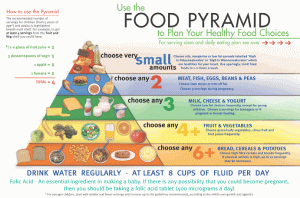http://www.irishpride.ie
To make it a little easier to see what you should be including in your diet to make it healthy, nutrition experts have come up with the concept of the food pyramid. The idea is to eat more foods from the shelves which are larger and less from those which are smaller.
Scroll over the food pyramid to see how many servings you should be eating a day from the various groups.
- Bread, rice, potatoes, pasta and other starchy foods
- Fruit and vegetables
- Milk and dairy foods
- Meat, fish, eggs, beans and other non-dairy sources of protein
Bread, rice, potatoes, pasta and other starchy foods
Starchy foods such as bread, breakfast cereals, oats, rice, pasta and potatoes provide energy which is important for growth and activity. These foods also provide B vitamins, fibre and some iron and calcium (in fortified bread and breakfast cereals).Fruit and vegetables
These are a really important part of the diet and provide fibre and a variety of vitamins and minerals. Nutritionally, frozen are just as good as fresh fruit and vegetables, and you can also use dried and canned varieties (but limit those with added salt or sugar). Fruit juices and smoothies are also included in this group.Milk and dairy foods
Milk and dairy products such as cheese, yogurt and milk are a very important part of the diet. These foods are a very good source of calcium, which is important for bone development, as well as providing protein, zinc, vitamin A and vitamins B2 and B12.Meat, fish, eggs, beans and other non-dairy sources of protein
This food group includes lean meat such as chicken, lamb, pork or beef, meat products such as ham and sausages, as well as eggs and fish. These foods provide protein, iron, zinc, vitamin D and B vitamins. In addition, oily fish (e.g. salmon, trout and fresh tuna) is a rich source of omega-3 fatty acids and a good source of vitamins A and D.
Alternative sources of protein and iron include beans and pulses such as baked beans, kidney beans, lentils and chick peas (and foods made from them e.g. dahl and hummus). Other foods such as eggs, tofu and soya mince are also useful meat alternatives. Try to serve these foods with another food or drink that is rich in vitamin C (e.g. fruit and vegetables) as this will help with iron absorption.Foods high in fat and/or sugar
These foods should be kept to a minimum in a healthy diet as they don’t provide many nutrients but are very high in fat, salt and sugar which in excess can contribute to obesity, high blood pressure and dental caries.
For a more detailed breakdown on how to maintain a healthy, balanced diet download our guide below. Don’t forget to drink at least 8 glasses of water per day!

May 17, 2012 I did a similar post food pyramid. Thanks visit my blog.
ReplyDeleteThanks for the post. I always find nutrition so fascinating. And thanks for coming by to follow my blog. I really appreciate it. Best of luck with your blog! Cheers.
ReplyDelete-Brett
Thanks for visiting and comment, i like your blog, i appreciate the great work you did in your blog, wish you all the best and good luck.
ReplyDelete-Usama
Thanks, Usama. Likewise!
ReplyDeleteHi Brett, you are welcome! Thank you too!
ReplyDelete